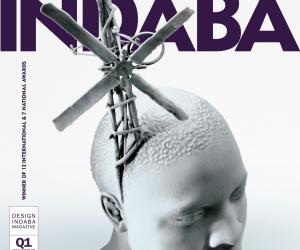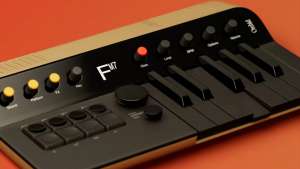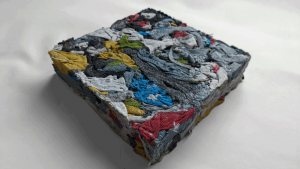First Published in
I know what you’re thinking. This is a design magazine, not a music magazine. This article is destined to stand around looking out of place at the cocktail party that is this month’s edition of Design Indaba. But the editor of the glossy publication you hold in your hand was busy putting together an issue looking at the new craft design movement, and noticed that it started being referred to as a movement round about the same time that people started speaking of a new folk music. Many design trends, such as minimalism, have musical equivalents, and if new craft went looking for its aural counterpart, new folk would have to be it.
If new craft sees a move away from mass-produced items towards a more home-grown, organic and homemade approach, so too does new folk. It is generally either authentic and earthy, or strives to be so. But as with new craft, there are those that would declare the idea of new folk as a movement in South Africa an invention of the media, or wish fulfilment on the part of various local artists who, feeling lonely making what generally is not a commercially viable form of music around these parts, are eager to feel part of a scene.
One thing is certain, though: there is currently a resurgence of acoustic music in South Africa. From the radio-friendly folk-pop of Josie Field, Farryl Purkiss, Dear Reader (as Harris Tweed is now known), ex-Sugardrive singer Paul Flynn and Laurie Levine, to the instrumental sounds of the likes of Guy Buttery and Nibs van der Spuy, and the raw sounds of more established (read “older”) folk-influenced artists such as Jim Neversink, Rian Malan, Riku Lätti, Dan Roberts, Drikus Barnard and Bacchus Nel. This is not to even mention the music of a growing crop of lesser known but up-and-coming artists whose music, while diverse, is all highly influenced by folk. The latter include Miss Texas 1977, Ella Joyce Buckley, Miles Sievwright, Arlyn, Aidan Cornhill, Matthew Gair, Tristan Waterkeyn, Naming James, Keira Witherkay, Rambling Bones (who incidentally is better known as Jay Bones, lead singer of ska-punk band Fuzigish) and my own alter ego, Deep Fried Man.
However, this inventory is a counterpoint to folk music’s original definition – which is what many would call world music today – as in, music indigenous to its country of origin and from a tradition of songs being handed down from generation to generation. If this is the case than it is actually home-grown music forms such as mbaqanga, maskanda, kwela and boeremusiek that are truly forms of South African folk music.
If this possibly old-fashioned definition of folk holds, then the most genuine purveyors of local folk music should be seen as those whose music blends acoustic guitar with African sounds, such as Vusi Mahlasela, Neo Muyanga or Madala Kunene. Or those whose music descends from traditional Afrikaans music, like Radio Kalahari Orkes, or from the goema music of Cape Town’s so-called coloured community, like Mac Mckenzie and the Goema Captains. Also capable of laying claim to being purveyors of a more locally derived folk sound are those whose music descends from the alternative Afrikaans movement of the 1980s, which centred around artists like Johannes Kerkorrel, Andre le Toit (who later became Koos Kombuis) and James Phillips (and his pseudo-Afrikaans alter-ego Bernoldus Niemand), who while best known as rock musicians, all had a strong folk element running through their work. Many current South African singer-songwriters, such as Matthew van der Want, Syd Kitchen, Robin Auld, Nel, Lätti and Malan, would acknowledge being influenced by these pioneers.
But those South African artists who would define their music as “new folk” or, who while resisting the tag, may be labelled as “new folk” by others, make acoustic-based music more influenced by contemporary United States folk artists than traditional local sounds. And, whether or not this is truly relevant, are almost all white. If new folk does exist, it descends from a tradition of songwriting that stems from the US and the UK, and is far removed from folk music as a culturally specific and traditional music form.
But it must be remembered that a man whose name is, for many, synonymous with folk music – Bob Dylan – was actually a white, urban, middle-class Jew pretending to be a poor itinerant rural hobo. Most of his contemporaries too, such as Leonard Cohen, Joni Mitchell and Donovan, shared similarly bourgeois upbringings. If folk was once a pure and authentic musical tradition, nowadays (by which I mean since the 1960s) it is more often music made by children of modern life who make this music precisely because they yearn for authenticity amid a global culture of strip-malls, fast food chains, petrol stations and reality television.
Anti-folk and avant garde folk are US movements that resist being pegged as new folk, although they are certainly concerned with the creation of a strain of the genre more relevant to our modern reality. While the members of the anti-folk movement primarily use acoustic guitars and song-structures derived from folk music, ideologically they have more in common with punk than traditional folk. The music of those involved is diverse enough to make the sound of anti-folk hard to define, however it’s generally raw, unpolished acoustic-based music with satirical lyrics. The sub-genre was born in 1984 in New York, with early practitioners including Axe Masterson, Billy Nova, Steve “Wheels” Cottrell, Irving Louis Lattin, Billy Syndrome, Ross Owen and his RoarSharks, Zane Campbell, and Michael America. Later on, some far better known artists spent time kicking about the New York anti-folk scene – the likes of Beck, Ani DiFranco, Regina Spektor, Michelle Shocked and the Moldy Peaches.
Then there is the truly underground avant garde US folk scene, which I know about solely due to recommendations by Cape Town-based experimental guitarist Righard Kapp, who says: “For some indication of what the implications of a folk avant garde could be, I suggest reading up on people like Cornelius Cardew, Fred Frith and John Fahey”. Kapp also mentions the “freak folk scene” in the US, which includes such delicately named acts as Jackie O Motherfucker and Sunburned Hand of the Man. But Kapp’s references are more underground than most. To many people, the US new folk scene refers to better known (but still not at all mainstream) acts such as Sufjan Stevens, the late Elliot Smith, Damien Rice, Davendra Banhart, Iron and Wine, and Neutral Milk Hotel.
Locally, a newsletter sent out near the end of last year by folk-minimalist artist Arlyn, promoting what he calls his Folk Avant Garde tour of the Western Cape, is among the first pieces of writing I have read to define what is happening locally in the acoustic-based music scene. “Of late”, reads the press release, “there seems to be something going on in SA folk. Nu-folk stalwarts Cabins in the Forest finally release their debut album, Tristan Waterkeyn starts up music industry mega-site overtone.co.za, and Magna Carta, bastions of the 1970s folk revival, tour SA twice in two years, with Arlyn in support. Left-of-leftfield musician Righard Kapp exchanges his trusty no-input mixing desk for an upside-down acoustic guitar and Miles Sievwright emerges with a handful of truly revelatory arrangements. That’snot to mention the exploits of Matthew Gair, Ella Joyce Buckley, Naming James, Deep Fried Man… Something is definitely afoot, and so we might as well say it: Scene!”
But Kapp isn’t having any of this. If there is a new folk scene, he certainly does not want any part of it. Like other artists I spoke to, he seems particularly irked by the idea of spelling “new folk” as “nu-folk”, as in the above press release. “I feel that the whole ‘nu-folk’ thing is extremely corny. It’s hardly descriptive of anything and I definitely don’t feel my music can be categorised this way. The whole ‘nu’ prefix is usually applied to rave music – it’s a neologism that signifies a synthetic, lumo-coloured kind of revelry in fakeness, so it’s a complete contradiction in terms to attach it to a form of music that ostensibly revels in authenticity and earthiness.” (Kapp is one of the primary reasons that I went with the “new folk” spelling rather than “nu-folk” in this feature.)
Van der Want is a veteran, so I thought if anyone can offer insight into whether or not new folk music actually exists it’s him. But Van der Want, like Kapp, is not so comfortable with the idea of being called a folk artist, let alone a new folk artist. He says: “I’ve always been particularly ashamed of the term ‘folk’ for some reason, even though some of my influences were very folksy, like Leonard Cohen or Suzanne Vega. I am sure that some people have referred to me as a folk artist before, but I think I am actually quite label-averse – I think the only labels that are applicable to music are ‘bad’ or ‘good’.”
Then there are those artists who seem rather unconcerned with the new folk tag, such as eclectic Capetonians Fly Paper Jet, who say: “Our music could be described as new folk, however, as far as listening and watching goes, we are more interested in Cape Town’s jazz scene – acts like Babu, Restless Natives and Mantras for Modern Man. If there is a new folk scene in South Africa, we are unaware of it.”
But there are also plenty of local artists who are quite comfortable with the idea of new folk music. In the more commercial corner is Field, whose first album shifted 7 000 copies (a huge amount by local singer-songwriter standards) and has just released her second album Leyland. She certainly sees herself as a new folk artist, saying: “There absolutely is a new folk scene in South Africa and it’s getting bigger and better every day. I feel like people have decided to put aside their electronic sampler for a bit, wipe off their dad’s dusty guitar and give it a strum – I think in this day and age everyone’s keen on getting back to basics, for a simpler lifestyle.”
Also on the more radio-friendly side of things is smooth singer-songwriter Purkiss, who is often compared with Jack Johnson. He acknowledges the existence of a new style of folk, saying: “The bones of it is still the traditional approach to folk – acoustic, melody-driven, strong songwriting. It’s come a long way from the singer-songwriter approach. Now people are combining that with other genres that interest them. Bands such as The Fruitbats and The Notwist are for me good examples of combining traditional folk with electronic elements.” He is reluctant to define his own music as new folk though, saying: “I am not a huge fan of putting a label on my music.”
Levine, a South African Music Award-nominated folk-pop singer-songwriter, says: “The new folk genre incorporates some of the principles and sounds inherent in the folk tradition. However, it is generally less politically driven than the old folk that it draws its inspiration from, and it incorporates contemporary sounds. New folk is thus not necessarily just folk – it’s a blend of styles but its core reference is folk. In a way, then, old folk is the pure form, and new folk is a derivative.”
My favourite act from the more commercial camp of local folk-influenced artists is Dear Reader, formerly called Harris Tweed. Their music is simple, honest and unpretentious, as is lead singer Cherilyn MacNeil’s answer to my question about whether or not new folk music exists. “I don’t care much for genres, and to be honest, I have no idea. New folk, old folk, I don’t even really know what folk is. I just know that I like a lot of artists that have ‘folk’ written on the album sleeve somewhere. And I call our music folk because I feel like folk music as I know it has a thread of something honest, something heartfelt and something narrative. And I like those things, and hope that they can be found in our music.”
Jim Neversink is one of the few local purveyors of alt-country, a music form that is inextricably linked to the US folk music tradition. He responded to my query about the existence of new folk music with an interesting but long and rambling monologue, which follows in heavily edited form. “New folk does exist. What it means is that, like any new genre, it starts off as counter-culture, until it is noticed by the mainstream.” Neversink feels that when this happens the music gets watered down. “Acoustic guitars that once played revolution songs are now strumming ballads about unrequited love, in the manner of David Gray, James Blunt and others. It infuriates me to think that record companies can reward such bad behaviour.”
“Folk music is really the music of the people”, he continues. “A type of storytelling through song. Therefore, it is important that maskanda and Indian music also make its way to big white-dominated festivals in this country. New folk is only different to old folk because people have more genres to blend it with, for example if rap or drum’n’bass is fused with storytelling, it’s still folk music. Folk music is a strong yet malleable genre, like blues, jazz and country. What is great about folk is that it has harnessed itself to several genres, so that the artists themselves can add their own descriptions, like freak folk, country folk or psychedelic folk. Personally, I call my music ‘loserbilly music’, and my website www.jimneversink.com may explain why,” adds Neversink, cleverly managing to plug his website while delivering his answer. “I’m not sure that my music is new folk”, he concludes, “but if new folk supporters like my sound and want to adopt me, that’s fine.”
Some would define folk as being necessarily lyrically based, but artists such as virtuoso Durban-based guitarist Guy Buttery, whose music is instrumental but stems from a folk tradition, refute this assumption. “I play instrumental music. Folk music almost always entails someone verbalising a story or a message, however there have been huge instrumental artists who everyone considers ‘folk’. Regardless, I believe the sounds I bind represent a voice for today, yesterday and tomorrow in some way. Using elements from the psychedelic folk guys or covering a Joanna Newsom track, I feel there is a bit of new folk in there somewhere. The awesome Cape Town-based band Cabins in the Forest represents the new folk scene here in SA like no other – full on psychedelia, long jams and, most importantly, a message. And the scene continues to grow.” (RIP: Cabins in the Forest disbanded shortly after I first wrote this article – so much for that horse.)
Whether or not there is a new folk scene, the decision of Jay Bones, lead singer of one of the country’s biggest bands, ska-punk stalwarts Fuzigish, to pick up an acoustic guitar and reinvent himself as a troubadour called Rambling Bones, may be seen as a sign that local folk music is on the up-and-up. Does Rambling Bones think there’s a new folk scene? “If you are writing about it, then it does exist. But maybe new folk isn’t so new. When young Dylan was jamming songs in New York and stalking Woody Guthrie, maybe people were saying ‘Who is the new folk guy?’ Concerning South Africa, I am on the road to find out if there is a scene, but it would appear so. I am not sure if my stuff is new folk or what, because I am not sure what new folk is (or anti-folk, for that matter), but I would say it is a guy with an acoustic guitar singing songs.”
Naming James, who is becoming known as a sharp and original storyteller on the Johannesburg singer-songwriting scene, says: “The roots of folk music lie in storytelling, which people have done and will do forever, so if there was any difference between the old and the new folk I’d say that it’s just a matter of new ideas and things to talk about served up on a classic platter of verse, chorus and the odd chord change. I would consider my music part of the new folk genre and would encourage people to come and really listen to shows where people are actually saying something (whether happy, sad, serious or ridiculous) in their music. I think that there is a great bubbling beneath the surface in SA and the steam that is leaking through the air has a distinct smell of new folk.”
Then there’s Arlyn, who makes delicate mythical music backed by vibraphone. He’s the guy who wrote the press release declaring that there is indeed a new folk scene in South Africa. According to him, those that see too much diversity among the artists mentioned here to call it a scene are missing the point. “I don’t think that social happenings have to be defined by concepts, there doesn’t have to be one central concept for there to be a movement going on. New folk is, I think, various people’s efforts to bring the power and mystery of folk into today’s idioms. Folk is always important: every culture has its folk tradition, and the reason it survives is because it has some kind of deep relevance to culture. I mean, the only reason we know folk songs is because they’re so good that they’re still being sung after 500 years! There’s something important about that.”
And finally there’s me, or more specifically my alter-ego Deep Fried Man, purveyor of cynical and humorous songs soaked in apathy, rejection, hate and rage. My songs are influenced by folk artists as well as by hip-hop, punk and soul. I have heard way too many different opinions on the matter to have a coherent opinion of my own as to whether or not there is a new folk scene in South Africa, but I will say the following: My music has, thus far, had precious little exposure. If the existence of a scene helps my songs reach a wider audience I will not complain. And I get lonely making the kind of music I make sometimes, so I hope there’s a scene, and if there is I’m not going to be the one to doubt it.















